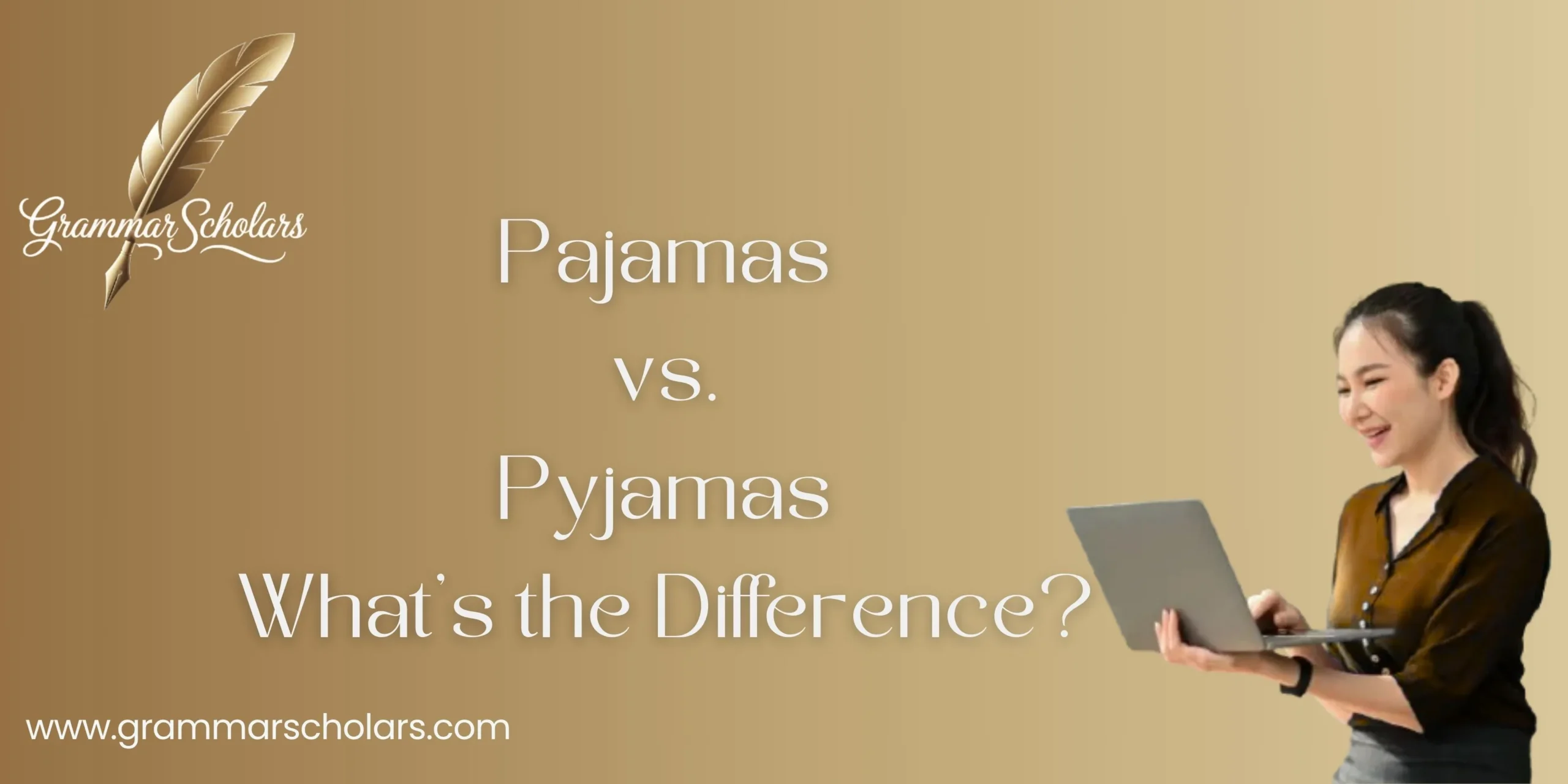It’s fun how a small spelling difference can open a story about how people speak, live, and even sleep differently. Both pajamas and pyjamas refer to comfy sleepwear, also known as nightwear or bedtime attire. The key distinction lies in usage: American English favors pajamas, while British English sticks with pyjamas. This change is more than stylistic- it reflects culture and language. The phrase “Pajamas vs. Pyjamas” shows how one word can tell us so much about identity, dialect, and where we live.
When you shop or browse labels, you’ll often spot how retailers use terms that match local preferences- like “pyjamas” in London versus “pajamas” in New York.
The spelling might differ, but the meaning remains. These quirks in vocabulary reveal more than language- they reflect pride, culture, and linguistic nuance. If you enjoy discovering such language twists, following how different English variants develop can help you appreciate the world’s diverse lexical habits.
What Are Pajamas (or Pyjamas)?
At their core, pajamas or pyjamas are loose-fitting garments worn for sleeping or lounging. They’re usually made from soft fabrics like cotton, silk, flannel, or jersey.
Pajamas are designed for comfort, and over time, they’ve also become a fashion category of their own. From button-down sets and footie PJs to luxury satin sleepwear, pajamas have evolved with culture and technology.
“Pajamas are more than clothes; they’re a nighttime ritual, a comfort zone, and sometimes, a statement.”
Standard Definitions
| Source | Definition |
| Merriam-Webster (US) | Clothing for sleeping or lounging: a loose, usually two-piece, lightweight suit |
| Oxford English Dictionary (UK) | Loose-fitting jacket and trousers worn for sleeping or relaxing in |
Despite the spelling difference, both versions mean the same thing.
Etymology & Historical Origin
The word pajamas or pyjamas has an exotic origin, tracing all the way back to South Asia.
Persian and Urdu Roots
The term originated from the Persian word “pāy-jāma” (پايجامه):
- “Pāy” = leg
- “Jāma” = garment or clothing
Put together, it meant “leg garments” – loose trousers tied at the waist, worn by both men and women across Persia, India, and surrounding regions.
British Colonial Influence
During British colonial rule in India (mid-18th to early 20th century), English-speaking colonists adopted the word and the attire. They brought both back to Britain, calling them pyjamas – incorporating them into nighttime attire.
This was more than cultural borrowing. It was linguistic evolution.
American Reform & Simplification
In the early 19th century, Noah Webster of the United States proposed spelling reforms to simplify English. That’s where pyjamas became pajamas.
This wasn’t random. He wanted to cut unnecessary letters and make spelling more phonetic. His dictionary cemented the American version.
Spelling Differences: Pajamas vs. Pyjamas
Why Are There Two Spellings?
The divide is simple:
- American English: Pajamas
- British English and Commonwealth nations: Pyjamas
Both are correct, but location dictates preference.
“The difference between ‘pajamas’ and ‘pyjamas’ is the Atlantic Ocean.”
Regional Spelling Preferences
| Country/Region | Preferred Spelling |
| United States | Pajamas |
| Canada | Pajamas (also pyjamas used occasionally) |
| United Kingdom | Pyjamas |
| Australia | Pyjamas |
| New Zealand | Pyjamas |
| India | Pyjamas |
| South Africa | Pyjamas |
In global usage:
- Google US heavily favors pajamas
- Google UK shows pyjamas as the dominant spelling
- Canadian English leans slightly American, but publications use both
Visual Comparison from Google Trends
Search interest over time shows clear regional distinctions.
matlab
CopyEdit
| Search Term | USA (%) | UK (%) | India (%) | Australia (%) |
|————–|———|——–|————|—————-|
| Pajamas | 97% | 3% | 29% | 18% |
| Pyjamas | 3% | 97% | 71% | 82% |
Usage in Real-World Contexts
Sentence Examples
American Usage:
- “I just bought new pajamas for the winter.”
- “He lounged in his pajamas all day after the party.”
British/Commonwealth Usage:
- “She ironed his pyjamas before packing for the trip.”
- “Don’t forget your pyjamas for the sleepover!”
Usage in Grammar
- The word is plural: “My pajamas are new,” not “My pajamas is new.”
- The singular version (rare): a pair of pajamas, but this isn’t used often outside of formal or retail language.
Cultural and Linguistic Influences
British Colonial Footprint
From India to Nigeria, Pakistan to South Africa – many countries inherited British spellings due to colonial history. That’s why pyjamas still dominate across:
- South Asia
- Southern Africa
- Oceania
The spelling reflects a shared linguistic history.
American Cultural Export
Thanks to Hollywood, pop music, and global fashion brands, American spelling has made inroads worldwide. Brands like:
- Old Navy
- Target
- Victoria’s Secret
All use “pajamas” in global advertising, contributing to its global familiarity, even where “pyjamas” is still locally correct.
Other Language Influences on Pajama Terminology
Here’s how different languages spell or adapt the word:
| Language | Word for Pajamas | Notes |
| French | Pyjama | Influenced UK usage |
| German | Schlafanzug | Literally “sleep suit” |
| Italian | Pigiama | Borrowed from English/French |
| Spanish | Pijama | No “y” used |
| Japanese | パジャマ (pajama) | Borrowed from English, transliterated into katakana |
These variations show how global and adaptable the concept is.
Common Phrases and Colloquial Uses
Pajamas and pyjamas aren’t just functional; they’ve entered pop culture and casual speech.
Idioms & Expressions
- “Party in your pajamas” – informal, relaxed vibe
- “Pajama day” – dress-down day at school or work
- “All dressed up with nowhere to go- in pajamas” – humorous contrast
- “Put your big boy pajamas on” – slang for “be responsible” or “grow up”
Slang & Regional Variants
| Region | Informal Word for Pajamas |
| USA | PJs, jammies |
| UK | Jim-jams, pyjamas |
| Australia | Jarmies |
| Canada | PJs |
| India | Pyjamas (often spelled the same but pronounced differently) |
Pajamas vs. Pyjamas in Media and Pop Culture
Film and Television Examples
- The Boy in the Striped Pyjamas (UK spelling) – Internationally acclaimed novel and film
- Pajama Party (1964) – American musical comedy
- SpongeBob SquarePants – Frequently uses “pajamas” in dialogue
- Bluey (Australia) – “Pyjamas” seen in episode dialogue and merchandise
Children’s Books and Literature
- “Llama Llama Red Pajama” – American children’s book series
- Enid Blyton stories – Frequently refer to “pyjamas” for bedtime scenes
- Harry Potter series – British usage: “Ron was still in his pyjamas.”
The media tends to stick to local spelling norms, reinforcing the cultural divide.
Spelling in Branding and Product Descriptions
E-commerce & SEO Strategy
Retailers target audiences differently depending on the region. A few examples:
| Platform | US Listing Term | UK Listing Term |
| Amazon | Pajamas | Pyjamas |
| Etsy | Pajamas | Pyjamas |
| Marks & Spencer | – | Pyjamas |
| Walmart | Pajamas | – |
For global sellers:
- Use localized content to target correctly.
- In meta tags, include both spellings for better visibility.
Psychological and Emotional Associations
Clothing isn’t just fabric – it’s tied to identity and routine.
- Americans may associate “pajamas” with comfort, nostalgia, and bedtime stories.
- Britons might link “pyjamas” with boarding school rituals or Sunday morning cartoons.
In both cases, it’s not just a spelling – it’s an emotional touchpoint.
“Language is memory made visible. Spelling is how we wear it.” – Linguist Deborah Cameron
Spelling Beyond Pajamas: Other UK vs US Variants
| Word (UK) | Word (US) |
| Pyjamas | Pajamas |
| Colour | Color |
| Organise | Organize |
| Theatre | Theater |
| Defence | Defense |
These differences aren’t errors – they’re reflections of linguistic evolution and cultural identity.
Quick Reference Guide: Pajamas vs. Pyjamas
| Use Case | Spelling to Use |
| Writing for an American audience | Pajamas |
| Writing for the UK/Commonwealth | Pyjamas |
| Global e-commerce site | Use both or tailor by region |
| Academic publication | Match your style guide (APA, MLA, etc.) |
| Social media | Use what fits your tone |
Pajamas vs. Pyjamas
There’s no “correct” spelling in an absolute sense. It all depends on where your audience is, who you’re speaking to, and what tone you’re using.
- If you’re writing for Americans, → stick with pajamas
- If your readers are British, Aussie, or Indian → go with pyjamas
- For global content → mention both, or choose a neutral tone
Language isn’t static. It bends with time, place, and purpose. Spelling is just one way we reflect where we come from – and sometimes, what time we go to bed.
So, whether you wear pajamas, pyjamas, jammies, or jim-jams, remember: you’re always saying the same thing.
Additional Resources
- Merriam-Webster: Pajamas
- Oxford Learner’s Dictionary: Pyjamas
- Google Trends Comparison: Pajamas vs Pyjamas
- The Boy in the Striped Pyjamas – Goodreads
Final Thoughts
Language is a living, breathing thing. It changes, adapts, and reflects the culture and people who use it. The case of “pajamas vs. pyjamas” is a classic example of how English, though shared across continents, can take on distinct local flavors.
Whether you’re wrapping up a novel in your striped pyjamas in London or scrolling through Netflix in your cotton pajamas in New York, the meaning doesn’t change – just the spelling.
Here’s what matters:
- Know your audience.
- Choose spelling based on regional consistency.
- Use both variations wisely if you’re writing for an international readership.
- Understand the cultural story behind the word – it adds richness to your writing.
In the end, it’s not about picking a “correct” version. It’s about choosing the one that fits your voice, your context, and your reader.
So next time someone asks, “Pajamas vs. pyjamas?” – you’ll know the answer is: both are right, depending on where you are.
FAQs
What’s the difference between pajamas and pyjamas?
The only difference is in spelling. “Pajamas” is the preferred spelling in American English, while “pyjamas” is used in British English and other Commonwealth countries. Both refer to the same type of sleepwear.
Is one spelling more correct than the other?
No. Both pajamas and pyjamas are correct, depending on regional spelling conventions. Use “pajamas” for American audiences and “pyjamas” for British, Australian, or Indian readers.
Where did the word ‘pajamas’ come from?
The word originated from Persian and Urdu: “pāy-jāma”, meaning “leg garment.” It entered English through British colonial influence in India and later evolved into different spellings based on regional English norms.
Why do Americans say pajamas but the British say pyjamas?
The difference stems from Noah Webster’s spelling reforms in the United States. He simplified British spellings to better reflect pronunciation. That’s why Americans dropped the “y” and kept it as “pajamas.”
Are pajamas always plural?
Yes. Pajamas (or pyjamas) are typically treated as a plural noun, similar to “trousers” or “scissors.” You’d say, “Where are my pajamas?” not “Where is my pajama?”











